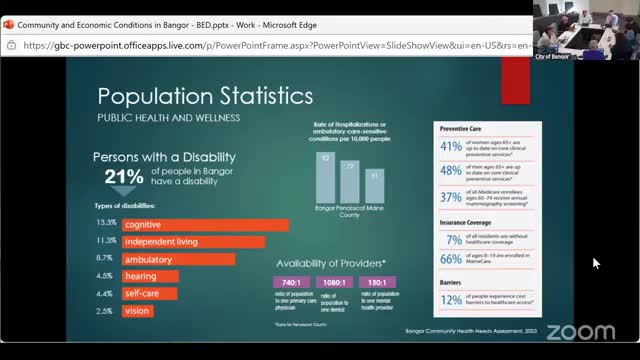Bangor Reports Improved Healthcare Metrics Amid Rising Drug Overdose Deaths
August 18, 2025 | Bangor City, Penobscot County, Maine
This article was created by AI summarizing key points discussed. AI makes mistakes, so for full details and context, please refer to the video of the full meeting. Please report any errors so we can fix them. Report an error »

In the heart of Bangor, Maine, city officials gathered to discuss pressing health care issues that resonate deeply within the community. As the meeting unfolded, the focus turned to the region's health care landscape, revealing both strengths and challenges that shape the lives of its residents.
One of the standout points was Bangor's impressive ratio of primary care doctors to residents, standing at 740 to 1, significantly better than the national average of 1,330 to 1. This statistic underscores Bangor's role as a regional health care hub, providing essential services to its community. However, the conversation quickly shifted to the need for continued improvement in access to quality health care, particularly for children, as the committee explored ways to bolster the number of qualified health care professionals.
The meeting highlighted a commendable statistic: only 7% of Bangor's residents lack health care coverage. This low percentage is crucial, as it alleviates some of the stress on local hospitals. Yet, the committee noted a concerning trend—many children in the area require health care assistance. Immunization rates for children are notably high, with 92% receiving the Tdap vaccine, compared to just 59% of adults up to date on their tetanus shots. This disparity raises questions about adult health awareness and access to vaccinations, especially as the state offers free or low-cost pediatric vaccines.
As the discussion progressed, the committee examined lifestyle factors affecting health in Bangor. Alarmingly, 31% of residents are classified as overweight, and 23% report no leisure time for physical activity. These figures prompted a conversation about the need for improved infrastructure to encourage outdoor activities and promote physical wellness among residents.
The meeting also addressed serious health concerns, including the prevalence of cardiovascular disease and chronic obstructive pulmonary disease (COPD), often linked to smoking. While Bangor has seen a decrease in smoking rates, the community still grapples with the impact of drug-related issues. In 2024, Penobscot County recorded 490 fatal drug overdoses, with 18% occurring within Bangor. This statistic highlights the urgent need for comprehensive strategies to combat substance abuse and its devastating effects.
As the meeting drew to a close, the committee reflected on the significant role of insurance in children's health care, noting that 66% of kids under 19 are enrolled in MaineCare. This high percentage indicates that many families are navigating economic challenges, emphasizing the importance of accessible health care services.
The discussions at this meeting not only shed light on Bangor's health care strengths but also illuminated the areas that require urgent attention. As the city moves forward, the commitment to enhancing health care access and addressing lifestyle factors will be crucial in fostering a healthier community for all its residents.
One of the standout points was Bangor's impressive ratio of primary care doctors to residents, standing at 740 to 1, significantly better than the national average of 1,330 to 1. This statistic underscores Bangor's role as a regional health care hub, providing essential services to its community. However, the conversation quickly shifted to the need for continued improvement in access to quality health care, particularly for children, as the committee explored ways to bolster the number of qualified health care professionals.
The meeting highlighted a commendable statistic: only 7% of Bangor's residents lack health care coverage. This low percentage is crucial, as it alleviates some of the stress on local hospitals. Yet, the committee noted a concerning trend—many children in the area require health care assistance. Immunization rates for children are notably high, with 92% receiving the Tdap vaccine, compared to just 59% of adults up to date on their tetanus shots. This disparity raises questions about adult health awareness and access to vaccinations, especially as the state offers free or low-cost pediatric vaccines.
As the discussion progressed, the committee examined lifestyle factors affecting health in Bangor. Alarmingly, 31% of residents are classified as overweight, and 23% report no leisure time for physical activity. These figures prompted a conversation about the need for improved infrastructure to encourage outdoor activities and promote physical wellness among residents.
The meeting also addressed serious health concerns, including the prevalence of cardiovascular disease and chronic obstructive pulmonary disease (COPD), often linked to smoking. While Bangor has seen a decrease in smoking rates, the community still grapples with the impact of drug-related issues. In 2024, Penobscot County recorded 490 fatal drug overdoses, with 18% occurring within Bangor. This statistic highlights the urgent need for comprehensive strategies to combat substance abuse and its devastating effects.
As the meeting drew to a close, the committee reflected on the significant role of insurance in children's health care, noting that 66% of kids under 19 are enrolled in MaineCare. This high percentage indicates that many families are navigating economic challenges, emphasizing the importance of accessible health care services.
The discussions at this meeting not only shed light on Bangor's health care strengths but also illuminated the areas that require urgent attention. As the city moves forward, the commitment to enhancing health care access and addressing lifestyle factors will be crucial in fostering a healthier community for all its residents.
View full meeting
This article is based on a recent meeting—watch the full video and explore the complete transcript for deeper insights into the discussion.
View full meeting
